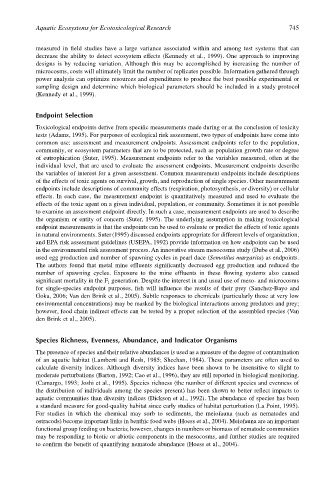Page 765 - The Toxicology of Fishes
P. 765
Aquatic Ecosystems for Ecotoxicological Research 745
measured in field studies have a large variance associated within and among test systems that can
decrease the ability to detect ecosystem effects (Kennedy et al., 1999). One approach to improving
designs is by reducing variation. Although this may be accomplished by increasing the number of
microcosms, costs will ultimately limit the number of replicates possible. Information gathered through
power analysis can optimize resources and expenditures to produce the best possible experimental or
sampling design and determine which biological parameters should be included in a study protocol
(Kennedy et al., 1999).
Endpoint Selection
Toxicological endpoints derive from specific measurements made during or at the conclusion of toxicity
tests (Adams, 1995). For purposes of ecological risk assessment, two types of endpoints have come into
common use: assessment and measurement endpoints. Assessment endpoints refer to the population,
community, or ecosystem parameters that are to be protected, such as population growth rate or degree
of eutrophication (Suter, 1995). Measurement endpoints refer to the variables measured, often at the
individual level, that are used to evaluate the assessment endpoints. Measurement endpoints describe
the variables of interest for a given assessment. Common measurement endpoints include descriptions
of the effects of toxic agents on survival, growth, and reproduction of single species. Other measurement
endpoints include descriptions of community effects (respiration, photosynthesis, or diversity) or cellular
effects. In each case, the measurement endpoint is quantitatively measured and used to evaluate the
effects of the toxic agent on a given individual, population, or community. Sometimes it is not possible
to examine an assessment endpoint directly. In such a case, measurement endpoints are used to describe
the organism or entity of concern (Suter, 1995). The underlying assumption in making toxicological
endpoint measurements is that the endpoints can be used to evaluate or predict the effects of toxic agents
in natural environments. Suter(1995) discussed endpoints appropriate for different levels of organization,
and EPA risk assessment guidelines (USEPA, 1992) provide information on how endpoints can be used
in the environmental risk assessment process. An innovative stream mesocosms study (Dube et al., 2006)
used egg production and number of spawning cycles in pearl dace (Semotilus margarita) as endpoints.
The authors found that metal mine effluents significantly decreased egg production and reduced the
number of spawning cycles. Exposure to the mine effluents in these flowing systems also caused
significant mortality in the F generation. Despite the interest in and usual use of meso- and microcosms
1
for single-species endpoint purposes, fish will influence the results of their prey (Sanchez-Bayo and
Goka, 2006; Van den Brink et al., 2005). Subtle responses to chemicals (particularly those at very low
environmental concentrations) may be masked by the biological interactions among predators and prey;
however, food chain indirect effects can be tested by a proper selection of the assembled species (Van
den Brink et al., 2005).
Species Richness, Evenness, Abundance, and Indicator Organisms
The presence of species and their relative abundances is used as a measure of the degree of contamination
of an aquatic habitat (Lamberti and Resh, 1985; Sheehan, 1984). These parameters are often used to
calculate diversity indices. Although diversity indices have been shown to be insensitive to slight to
moderate perturbations (Barton, 1992; Cao et al., 1996), they are still reported in biological monitoring.
(Camargo, 1993; Joshi et al., 1995). Species richness (the number of different species and evenness of
the distribution of individuals among the species present) has been shown to better reflect impacts to
aquatic communities than diversity indices (Dickson et al., 1992). The abundance of species has been
a standard measure for good-quality habitat since early studies of habitat perturbation (La Point, 1995).
For studies in which the chemical may sorb to sediments, the meiofauna (such as nematodes and
ostracods) become important links in benthic food webs (Hoess et al., 2004). Meiofauna are an important
functional group feeding on bacteria; however, changes in numbers or biomass of nematode communities
may be responding to biotic or abiotic components in the mesocosms, and further studies are required
to confirm the benefit of quantifying nematode abundance (Hoess et al., 2004).

